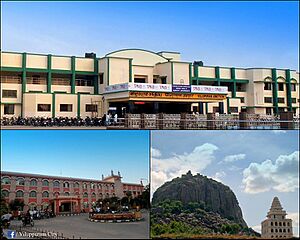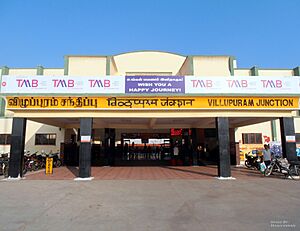Viluppuram facts for kids
Quick facts for kids
Villupuram
|
|
|---|---|
|
Special Grade Municipality
|
|

Viluppuram Junction, District Court, Gingee Fort
|
|
| Country | |
| State | Tamil Nadu |
| Region | Tondai Nadu |
| District | Viluppuram |
| Established | 1919 |
| Government | |
| • Type | Special Grade Municipality |
| • Body | Viluppuram City |
| Area | |
| • Total | 37.13 km2 (14.34 sq mi) |
| Area rank | 13 |
| Elevation | 71 m (233 ft) |
| Population | |
| • Total | 171,131 |
| • Density | 4,609.0/km2 (11,937.2/sq mi) |
| Languages | |
| • Official | Tamil |
| Time zone | UTC+5:30 (IST) |
| PIN |
605601,605602,605401,605103,605301
|
| Telephone code | +91–04146(STD Code) |
| Vehicle registration | TN–32,TN-16 |
| Distance from Chennai | 160 kilometres (99 mi) |
| Sex ratio | 998 ♂/♀ |
| Climate | Aw(Köppen) |
| Literacy | 90.16% |
Viluppuram, also known as Villupuram or Vizhuppuram, is a city in Tamil Nadu, India. It is the main city and administrative center of the Viluppuram district.
The city is about 61 km (38 mi) southwest of Tiruvannamalai and 40 km (25 mi) northwest of Cuddalore. It is a very important and large railway junction. National Highway 45 also passes through the city. Farming is a major way people earn money here. In 2011, Viluppuram had a population of 171,131 people. The city's literacy rate (how many people can read and write) was 90.16% in 2011.
Villupuram officially became a Municipality in 1919. Today, it has 42 areas called wards. This makes it the largest city in the Viluppuram district.
Contents
History of Viluppuram
In 1677, a famous leader named Shivaji took control of the Gingee area with help from forces from Golkonda. Later, in the 1700s, both the British and the French set up settlements in the South Arcot region.
During the Anglo-French rivalry, the whole area became a battlefield. After some time, the East India Company took control of the entire region. It stayed under British rule until 1947, when India became an independent country.
After India gained independence, the area we know as Viluppuram today was part of the larger South Arcot District. The main office for this district was in Cuddalore. On September 30, 1993, Viluppuram became the main city for the newly created Vizhuppuram District. This happened when the South Arcot District was divided into smaller parts.
Geography of Viluppuram
Vizhuppuram is located in the far southeast part of India. It is about 160 km (99 mi) south of Chennai and 160 km (99 mi) north of Trichy. The city is also 177 km (110 mi) east of Salem and 45 km (28 mi) northwest of Cuddalore. It is about 40 km (25 mi) west of Pondicherry, which has a seashore on the Bay of Bengal.
The land around Viluppuram has rocks that changed due to pressure and heat. These rocks are similar to granite and are called gneiss. There are also three main types of sedimentary rocks. These are layers of particles that settled down during different times in Earth's history.
The Kalrayan Hills forest park is about 116 km (72 mi) to the west. The Gingee Hills forest park is about 50 km (31 mi) to the north.
Climate in Viluppuram
Since Viluppuram is not near the coast, its weather is usually humid and hot. The city gets most of its rain from the monsoon season, which lasts from July to December. Summers are very hot, with temperatures sometimes reaching 40°C (104°F). Winters are milder, with temperatures between 30°C and 35°C (86°F and 95°F). Viluppuram has a tropical climate. It rains much less in winter than in summer. This type of climate is known as Aw/As in the Köppen climate classification.
The average temperature in Viluppuram each year is 28.4°C (83.1°F). The city gets about 1046 mm (41.2 in) of rain annually. March is the driest month, with only 6 mm (0.24 in) of rain. October gets the most rain, with an average of 222 mm (8.7 in). May is the warmest month, with an average temperature of 32.0°C (89.6°F). January is the coolest month, with an average temperature of 24.6°C (76.3°F).
| Climate data for Viluppuram | |||||||||||||
|---|---|---|---|---|---|---|---|---|---|---|---|---|---|
| Month | Jan | Feb | Mar | Apr | May | Jun | Jul | Aug | Sep | Oct | Nov | Dec | Year |
| Mean daily maximum °C (°F) | 28.8 (83.8) |
30.6 (87.1) |
32.9 (91.2) |
34.7 (94.5) |
37.1 (98.8) |
37.1 (98.8) |
34.5 (94.1) |
34.8 (94.6) |
34.2 (93.6) |
32.0 (89.6) |
29.5 (85.1) |
28.2 (82.8) |
32.9 (91.2) |
| Mean daily minimum °C (°F) | 20.4 (68.7) |
20.8 (69.4) |
22.7 (72.9) |
25.6 (78.1) |
27.0 (80.6) |
26.9 (80.4) |
25.9 (78.6) |
25.3 (77.5) |
24.9 (76.8) |
22.1 (71.8) |
22.5 (72.5) |
21.2 (70.2) |
23.8 (74.8) |
| Average rainfall mm (inches) | 20 (0.8) |
7 (0.3) |
6 (0.2) |
29 (1.1) |
45 (1.8) |
45 (1.8) |
89 (3.5) |
150 (5.9) |
130 (5.1) |
220 (8.7) |
216 (8.5) |
110 (4.3) |
1,067 (42) |
| Source: en.climate-data.org, | |||||||||||||
The difference in rainfall between the driest and wettest months is 216 mm (8.5 in). Throughout the year, the average temperatures change by 7.4°C (13.3°F).
People of Viluppuram
| Historical population | ||
|---|---|---|
| Year | Pop. | ±% |
| 1961 | 43,496 | — |
| 1971 | 60,242 | +38.5% |
| 1981 | 77,091 | +28.0% |
| 1991 | 88,788 | +15.2% |
| 2001 | 95,455 | +7.5% |
| 2011 | 96,253 | +0.8% |
Sources:
|
||
As of the 2011 census, the Viluppuram municipality had a population of 96,253 people. Out of these, 47,670 were male and 48,583 were female. The municipality is divided into 44 wards, and elections are held every five years for these wards.
| Religious census | ||||
|---|---|---|---|---|
| Religion | Percent(%) | |||
| Hindu | 78.35% | |||
| Muslim | 14.88% | |||
| Christian | 6.15% | |||
| Jain | 0.38% | |||
| Sikh | 0.02% | |||
| Buddhist | 0.01% | |||
| Other | 0.01% | |||
| No religion | 0.20% | |||
How Viluppuram is Managed
| Elected members | |
|---|---|
| Member of Legislative Assembly | R. Lakshmanan |
| Member of Parliament | D. Ravi kumar |
Politically, Viluppuram is part of the Vizhuppuram Lok Sabha constituency for national elections. It is also part of the Villupuram State Assembly constituency for state elections.
The city's local government, the municipality, was created in 1919. It has been upgraded several times:
- Second-grade municipality in 1953
- First-grade municipality in 1973
- Selection grade municipality in 1988
- Special grade Municipality in 2023
The city is divided into 42 wards. The municipal council has 42 councilors, one for each ward. The council is led by a chairperson, who is chosen by the city's voters. The councilors also choose a vice-chairperson from among themselves. The daily operations of the city are managed by a commissioner. The commissioner gets help from other officials, like a health officer, an engineer, and a town planning officer.
Getting Around Viluppuram
Road Travel
Viluppuram has good road connections to other major cities and to the rest of the state. Some important national highways that pass through or near the town include:
- NH 38: This highway connects Vellore and Thoothukudi. It goes through Viluppuram, Tiruchirapalli, and Madurai.
- SH 07: This state highway connects Viluppuram to Tirukoilur.
- SH 234: This state highway connects Viluppuram to Mangalore, passing through Thiruvannamalai and Hosur.
- SH 04: This state highway connects Viluppuram to Tirupati, going through Gingee and Vellore.
- NH 332: This national highway connects Viluppuram and Pondicherry.
- NH 132: This national highway connects Viluppuram and Tindivanam.
- NH NH 45A: This highway connects Viluppuram and Nagapattinam, passing through Pondicherry and Cuddalore.
- NH 36: This highway connects Vikravandi and Manamadurai. It goes around Viluppuram, about 5 km (3.1 mi) away in Koliyanur.
Train Travel
The Viluppuram Railway Junction is a very important train station. It helps send train traffic from Chennai, the capital of Tamil Nadu, to the southern parts of the state. Five different railway lines start or pass through Vizhuppuram:
- A fully electric double line goes towards Chennai Beach via Chengulpattu Junction.
- A fully electric double line goes towards Tiruchirapalli Junction. It passes through Vridhachalam Junction and Ariyalur. This is also called the "Chord Line" to Tiruchirapalli.
- A fully electric single line goes towards Tiruchirapalli Junction. It passes through Cuddalore Port Junction, Mayiladuthurai, and Thanjavur Junction. This is known as the Main Line.
- A fully electric single line goes to Katpadi Junction. It passes through Tirukoilur, Tiruvannamalai, and Vellore Cantonment.
- A fully electric single line goes to Pondicherry.
Air Travel
The closest airport is Pondicherry Airport in Puducherry, which is about 40 km (25 mi) from Viluppuram. You can fly from Pondicherry Airport to Bangalore with commercial airlines.
The nearest large airport is the Chennai International Airport (MAA). It is about 140 km (87 mi) away from the city. The next closest large airport is Tiruchirapalli International Airport, which is about 170 km (106 mi) from Viluppuram.
See also
In Spanish: Viluppuram para niños



